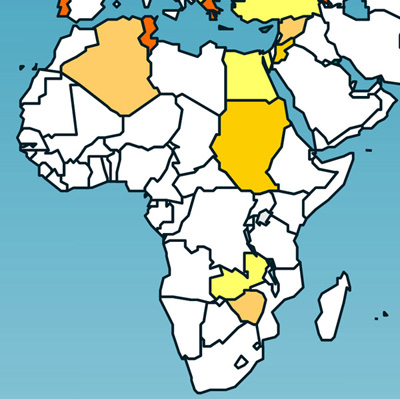The color-coded countries in the map below show ENPEP applications in Africa and the Middle East. Please keep in mind that these are the applications/studies that we are aware of at present. If you are an active ENPEP user and would like your country or analysis featured on this page, please >contact CEEESA.
| Country |
Users |
Project |
Brief Description |
Algeria |
Sonelgaz |
|
SONELGAZ, the State power company has used the MAED model for electricity demand forecasting and WASP for least-cost generating system expansion. |
Egypt |
Cairo University |
Energy Planning of the Transport Sector in Egypt in the Context of Environmental Concerns |
The objective of the ENPEP-BALANCE study was to identify and analyze the impact of implementing several energy policies and measures on transport sector energy demand and atmospheric emissions up to 2023. Energy policies considered are: fuel switching in vehicles from gasoline/diesel to compressed natural gas (CNG) as well as diesel to electricity for railways; energy pricing; energy conservation; and stimulation of public transportation. In addition to the energy and environmental impacts of implementing each policy/measure, the study also looked at the economic impacts. |
Jordan |
Ministry for Energy and Mineral Resources |
First National Communication
to the UNFCCC
|
The Ministry for Energy and Mineral Resources used ENPEP-BALANCE to conduct the GHG mitigation analysis presented in Jordan's First National Communication to the UNFCCC. |
Jordan |
Ministry for Energy and Mineral Resources |
Demand Forecasting and Generation System Expansion Analysis
|
The Ministry for Energy and Mineral Resources used the MAED and WASP models for energy demand forecasting and power sector expansion analysis. |
Oman |
Sultan Qaboos University |
Oman Power System Expansion Analysis |
The report describes a power generation expansion analysis for the Sultanate of Oman using the WASP model. |
Sudan |
Administration for National Energy Affairs |
Sudan Energy Economics and Power Planning Study Covering the period 1997-2020
|
Sponsored by the IAEA, Sudan's Ministry of Energy and Mining assessed the energy situation in Sudan and projected energy trends for the period until 2020. Using MAED, the study team evaluated the country’s energy requirements until the year 2020; assessed potential energy supply options; formulated an optimal power system expansion plan using the GENSIM model used by the National Electricity Corporation; established a balance between the available energy supplies and various demand sectors using the ENPEP-BALANCE model; and assessed cash-flow requirements and environmental impacts of the overall energy and electricity supply system by using ENPEP-BALANCE. |
Tunisia |
Ministry of Environment |
Tunisia UNFCCC First National Communication |
The Ministry for Environment used WASP to conduct the GHG mitigation analysis presented in Tunisia's First National Communication to the UNFCCC. |
Zambia |
CEEESA for the World Bank |
Zambia Long-Term Generation Expansion Study |
Sponsored by The World Bank, CEEESA developed a least-cost generation expansion plan for Zambia as part of the Power Rehabilitation Project. The study was carried out in close collaboration with a national team of experts from the Zambia Electricity Supply Corporation (ZESCO). The project also focused on capacity building at ZESCO, transfer of the computer models, and training of ZESCO staff in the use of the tools. The objective of the study was to analyze possible long-term development options for the Zambian electric power system up to 2015. The study involved a detailed hydro operations analysis of the Zambezi river basin and a systems planning analysis for the least-cost generation expansion. CEEESA used PC-VALORAGUA for the hydro operations and optimization studies and WASP to determine the optimum expansion schedule. |

